Think you can’t bake fresh, homemade sourdough bread? This easy sourdough bread recipe— trusted by beginner bakers for over a decade— shows you how, step by step. No yeast. No kneading. No noise. Just simple ingredients and 10 minutes of hands-on time for soft, crisp, sourdough bread at home.
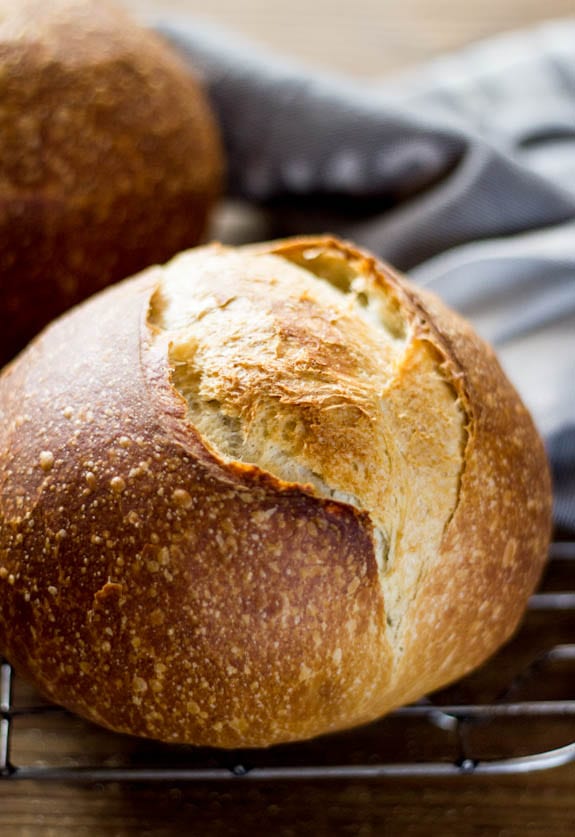
Reader review
“I have tried MULTIPLE sourdough bread recipes and this one has been the very first to make a successful (fully risen) loaf of bread. I am relatively new to sourdough and for some reason, the other recipes just didn’t produce good bread. These instructions and detailed explanations really make a huge difference to someone who is new to the world of sourdough.”
—Savannah
To anyone who thinks their sourdough bread is not good enough- I get it.
In 2013, I set a goal: bake more bread. I researched and tested countless loaves with both good and bad results. I started with this easy no-knead artisan bread recipe and eventually reached the holy grail: homemade sourdough bread.
Admittedly, I had beginner’s luck. My first loaves were light, plump and airy- everything you want sourdough to be. And then? I fell down the rabbit hole. Hydration? Baker’s %? Proofing times?
Naturally, I felt called to experiment. I made changes to my original recipe, things got technical, and I began to overthink everything trying other people’s methods instead of trusting my own! Then my beginner’s luck vanished. I snuffed out the sheer joy and undeniable value of learning through immersion. What remained was bread so heavy and dense, even my dog wouldn’t eat it.
So, I went back. Back down the rabbit hole, but this time with a new perspective: to re-learn from the ground up, balancing art, science and intuition. I took notes. Asked questions. Simplified the process. What I’ve learned, is that sourdough is not just a written recipe; it’s an understanding. And it’s only as simple as the person who explains it.
Now, with 13+ years of sourdough baking experience and a professional culinary background, I know what holds people back: the fear, hesitation, confusion, comparison. Teaching others from a practical, down-to-earth approach is my specialty.
This beginner sourdough bread recipe has been the most popular on my blog for over a decade. It earns millions of views and inspired my bestselling book Artisan Sourdough Made Simple: a deeper dive into the culinary world of sourdough bread recipes. So, if you’re at the end of your rope (and just want to make good bread) I get it. You’ve made it. Welcome to the journey.
What Sets This Recipe Apart:
- One bowl, 5 ingredients
- Olive oil = soft, plush crumb & crisp, golden crust
- No stand mixer
- No bread machine
- Flexible baker’s schedule
- Ongoing Q&A in the comments
What You’ll Learn
In this tutorial, I’ll teach you how to make fresh, homemade sourdough bread with step-by-step recipe instructions and videos for guidance. This easy sourdough bread recipe delivers a golden, crisp crust and an addictively chewy interior, thanks is part to a touch of olive oil, my signature twist. Use the dough as is, or customize it with your favorite additions like roasted garlic, rosemary, olives, jalapeños, cheese, and more.
But before we make bread, let’s discuss what drives it: your sourdough starter. Once you understand what it is, and how it works, your path will be crystal clear. Have questions? Ask in the comment section. I respond with personalized help. Let’s begin with the basics.
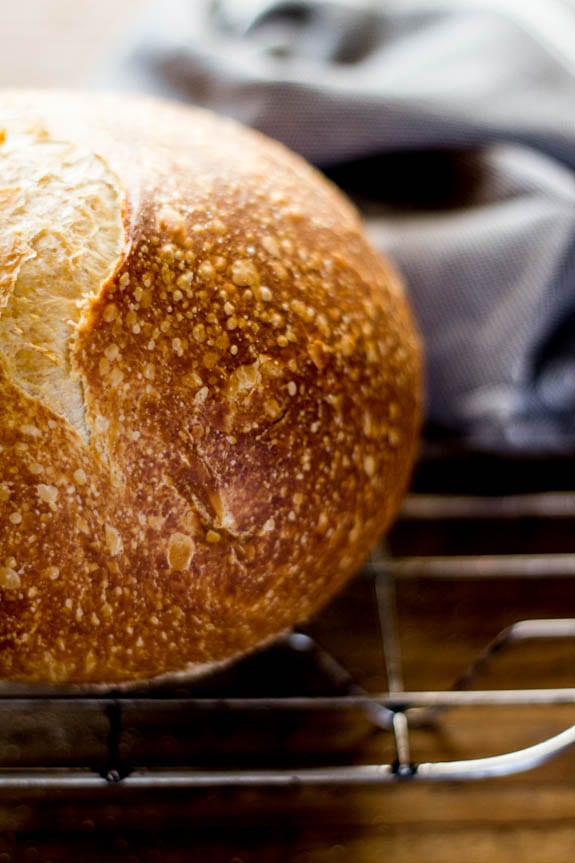
What Is Sourdough Bread?
Sourdough bread is naturally leavened, slow-fermented bread made without commercial yeast. It rises using a bubbly, active sourdough starter, which gives the bread its signature tangy flavor and chewy texture.
What Is Sourdough Starter?
A sourdough starter is a live, fermented culture made from flour and water. Over time, it develops wild yeasts and beneficial bacteria from the environment. A small amount is mixed into bread dough to make it rise naturally. Without it, you cannot make sourdough bread. Need a starter? Here’s my step-by-step sourdough starter recipe.
Where To Get A Sourdough Starter
Starters can be homemade, purchased, or gifted from a fellow baker. They also vary in texture, flavor, and flour type. I use two different starters: one I made myself, and one gifted to me by my friend Celia, who dried a portion of her starter and mailed it all the way from Sydney, Australia!
But it doesn’t stop there. One you have your sourdough starter, it must be kept alive with regular feedings to maintain maximum rising power. Sourdough is not just slow bread; it’s living bread. Every baker has a different routine. Here’s mine:
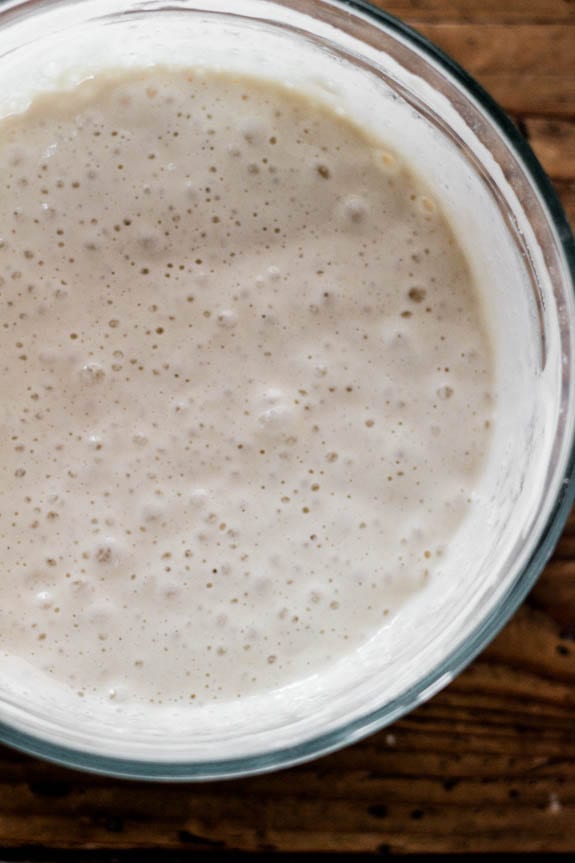
How To Feed Sourdough Starter
- Remove and discard half of your sourdough starter.
- Feed what’s left in the jar with equal parts flour and water by weight (1:1:1 feeding ratio).
- Let rise at room temperature (loosely covered or airtight) ideally 75+ F, until bubbly, active and double in size (2-12 hrs). I use this sourdough starter jar.
When Is Sourdough Starter Ready To Use?
Your fed stater is ready to use when it becomes bubbly, active and doubles in size. This can take anywhere from 2-12 hours or more depending on temperature and strength of your starter. Be patient!
Float Test: If you’re unsure whether your sourdough starter is ready, drop 1 tsp at peak height into a glass of water. If it floats to the top it’s ready to use. If it sinks, your starter should be fed again.
How To Use Sourdough Starter For Baking
Once your active starter is ready, pour out what you need for your recipe. That’s it. Then, feed what’s left in the jar with fresh flour and water to keep it going. Got extra starter? Use it in sourdough discard recipes like my sourdough pancakes, sourdough scones and fresh sourdough pasta.
Storage Options
If you only bake a few times a month, keep your sourdough starter in the fridge and feed it once a week. If bake often, store your starter at room temperature and feed it at least once a day.
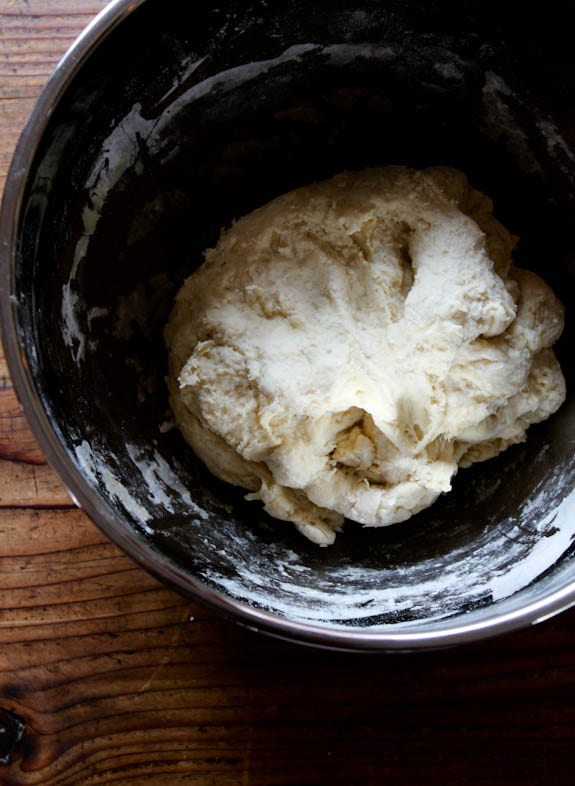
How To Make Sourdough Bread: Step-By-Step Recipe
Feed your sourdough starter until it’s bubbly and active—this is key for a strong rise. Then mix the dough (see baking schedule for timing). Detailed step-by-step instructions follow below. For a printable recipe with ingredients and measurements, scroll to the end of this post.
Step 1: Mix The Dough
- Mix water, sourdough starter, and olive oil in a large bowl. Add the bread flour and salt. Use a fork or dough whisk to start, then finish by hand until the flour is fully absorbed. The dough will feel rough and shaggy- this is normal.
- Cover the bowl with a very damp towel or plastic wrap and let rest (autolyse) for 30 minutes to 1 hour at room temperature. Then return to the bowl, and shape the dough into a rough ball (it doesn’t have to look perfect).
Pro Tip: weigh your ingredients with a digital kitchen scale. Measuring cups vary in size, and don’t account for ingredient density which can lead to dry, dense, or overly sticky dough.
What Is Autolyse?
Autolyse is the first resting period after mixing bread dough. It jumpstarts gluten development without kneading, making the dough stronger, more elastic, and easier to shape. This improves texture, flavor, and overall structure (one reason I never skip it). For this recipe, rest the dough for at least 30-45 minutes. When time permits, I’ll extend it to 1 hour for an even softer, more manageable dough.
A Note on Salt: Some bakers add salt after autolyse, believing it slows down gluten development. I’ve followed that method for years, but now I mix everything at once. It’s simpler, faster, and still produces excellent loaves (plus, you won’t forget to add the salt later on!). I’ll leave the choice up to you.
Want to Add Inclusions?
Mix in flavor additions after autolyse, when the dough is softer and more pliable- another reason not to skip the rest. Or, wait until the first stretch and fold.
A Few Ideas:
- Roasted garlic
- Chopped olives
- Fresh or dried herbs (rosemary, thyme)
- Seed or nuts
- Cheese
- Dried fruit (raisins, cranberries)
- Jalapeños

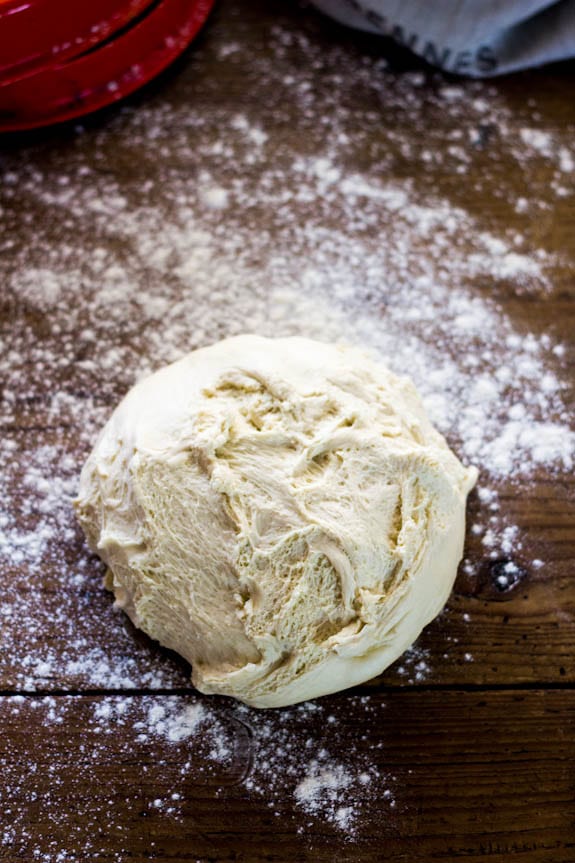
Step 2: Bulk Rise
Now the dough is ready to rise. This step is called the bulk rise or bulk fermentation.
Cover the bowl with lightly oiled plastic wrap (or transfer to a dough tub) and let rise at room temperature, about 68–70°F (20–21°C).
How Long Does It Take for Sourdough Bread to Rise?
The dough is ready when it’s puffy, slightly domed, and nearly doubled in size. This can take 3–12 hours depending on:
- Room temperature
- Strength of your starter
- Seasonal conditions
For example:
- In the summer: ~2–4 hours @ 80ºF (26ºC)
- In the winter: ~10–12 hours @ 68ºF (20ºC)
Tip: Temperature controls time. Sourdough takes longer than yeasted bread—don’t rush it. Watch the dough, not the clock. Be patient. Want to dive deeper? Read: Why Won’t My Sourdough Bread Rise? for details and troubleshooting.
Optional Step: Stretch And Fold The Dough
About 30 minutes into the bulk rise, you can perform a series of ‘stretch & folds’ to strengthen the bread dough. Although it’s not mandatory, this technique will add height and structure to the finished loaf. Watch the video tutorial below, or read this guide to learn how. It’s easy, hands-on, and a fun to do!
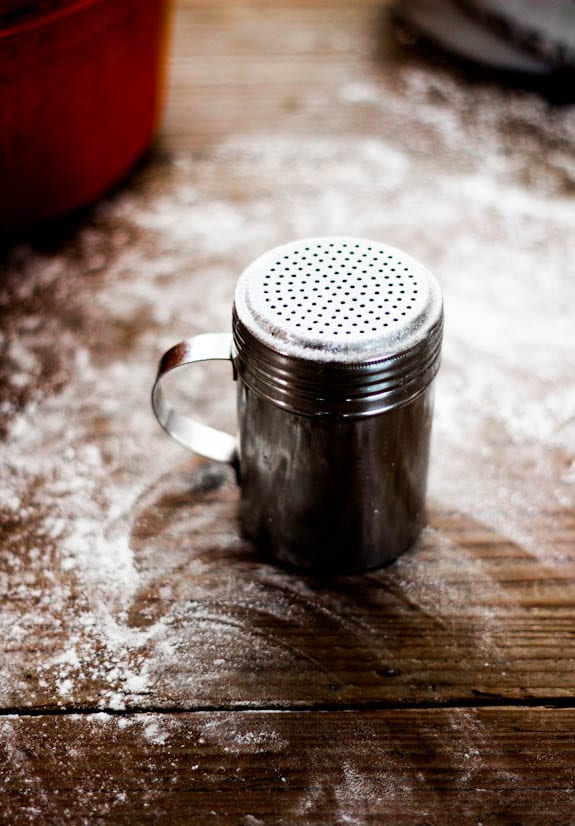
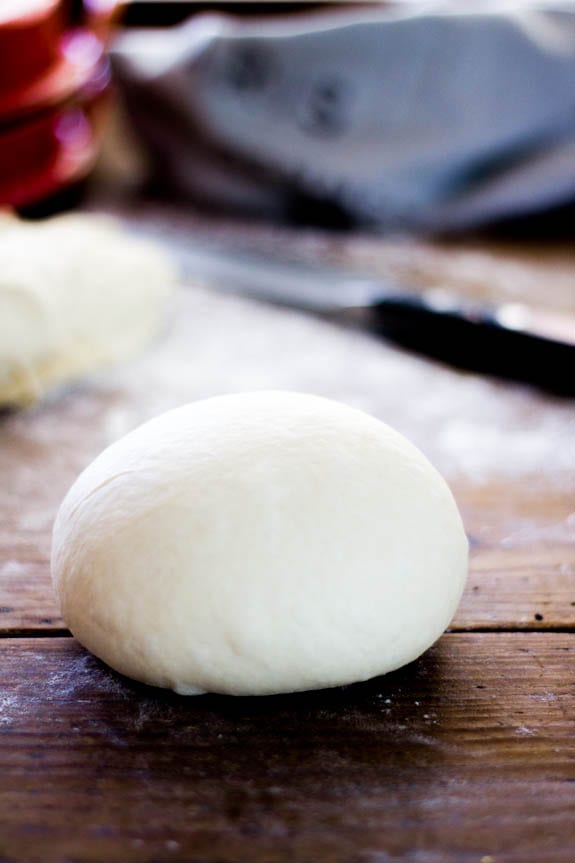
Step 3: Divide & Shape The Dough
- Turn the dough out onto a lightly floured surface.
- Divide the dough in half for 2 smaller loaves, or leave whole for a single larger loaf.
How To Shape A Round Sourdough Boule (Loaf)
Starting at the top, fold the dough over toward the center. Give it a slight turn, and then fold over the next section of dough. Repeat until you have come full circle to form a tight round. This creates surface tension for better oven spring. You can also use the envelope-style fold—both methods work well. Watch the video tutorial below.
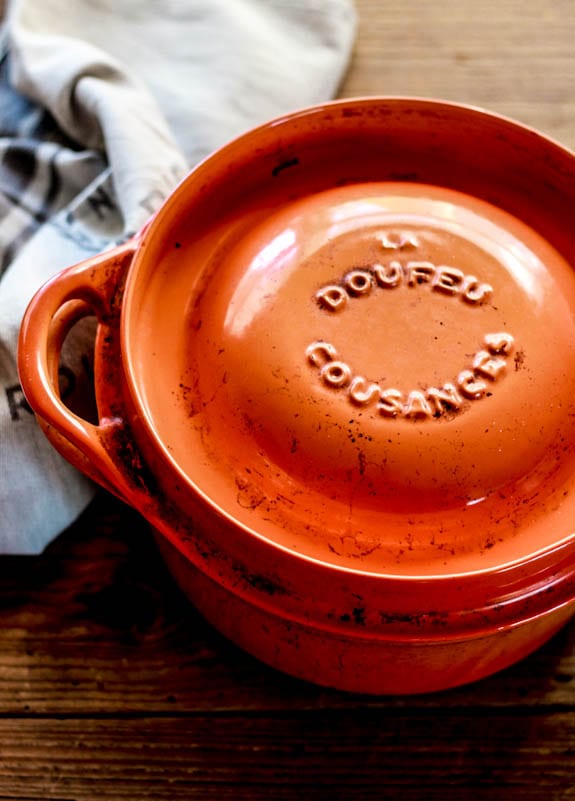
Step 4: Choose The Right Baking Pot
For best results, bake sourdough bread in a Dutch oven or a specialty pan like the Challenger Bread Pan (suitable for both round and oval loaves). Why? Pots trap steam, which is the secret to homemade sourdough with a bold rise. Without steam, the crust will set too fast, causing the loaf to harden, split or bake unevenly.
What If you don’t have a Dutch Oven?
You’ll need another oven-safe vessel to create steam. This is crucial. A few alternatives below:
- Enamel roasting pan with lid (or sheet pan to cover)
- Cast iron skillet with upside down roasting pan to cover
- Covered sandwich loaf pans
- Clay Baker or Romertopf (soaked first)
- Preheated baking stone w/ metal bowl to cover
Important: All baking vessels must be able to withstand up to 450 F/232 C (lid and handles included).
A deeper understanding: In the past, I’ve tried baking sourdough bread on just about everything: pizza stones, baking sheets, you name it—no luck. The crust always hardened too quickly. I used additional steaming methods to remedy this (e.g. ice cubes in a hot pan, spraying my loaves with water) but my home oven could not retain moisture. It was very dry. In my personal situation, a Dutch oven was the only reliable solution.
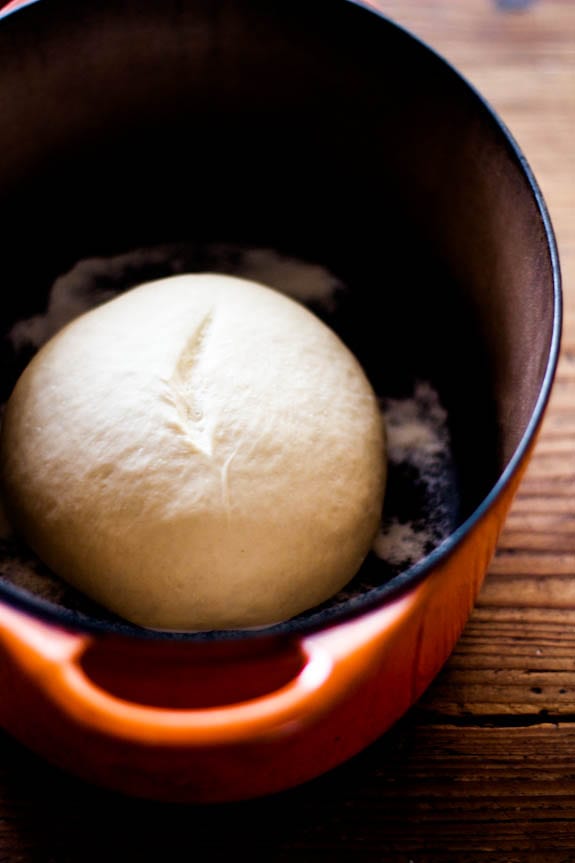
Step 5: Second Rise (Proofing)
- After shaping, your dough needs to rise again. This is known as the second rise or proofing.
- How to do it: Generously dust the bottom of your Dutch oven with cornmeal, or line it with non-stick parchment paper to prevent sticking. Gently place the dough inside (see tip below).
- Let the dough rise for 30 minutes to 1 hour, or until it’s visibly puffy and no longer feels dense. It doesn’t need to double in size—just look for expansion and softness.
- While the dough proofs, preheat your oven to 450ºF (232ºC).
Pro tip: Want better shape and structure? Proof the dough in a cloth-lined, 8-inch bowl or banneton instead of directly in the Dutch oven. This will contain the dough and hold its shape properly during the second rise.
Step 6: Score The Dough
- Right before baking, make a shallow slash down the center of the dough, about 2–3 inches long. This helps the steam to escape and allows the bread to expand or “bloom” in the oven.
- Use a sharp serrated knife, paring knife, or bread lame. Be quick and confident.
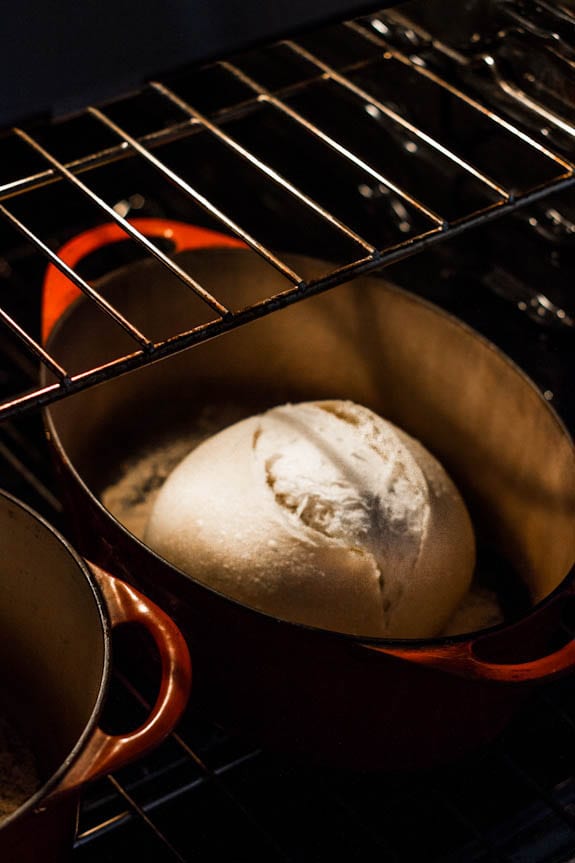
Step 7: Bake The Sourdough Bread
- Place the lid on the pot and reduce the oven temperature to 400º F/ 204º C.
- Bake on the center rack for 20 minutes. Then, carefully remove the lid. At this stage, your bread will look pale and slightly shiny—that’s normal.
- Continue baking uncovered for an additional 40 minutes, or until the crust is deep golden brown. The internal temperature should register between 205–210ºF /96–98ºC.
- Transfer the bread to a wire rack and cool for at least 1 hour before slicing. Be patient! If you cut into it too soon, the texture will be gummy.
Pro tip: During the last 10 minutes of baking, crack open the oven door to let moisture escape. This creates a crispier crust. Alternatively, remove the bread from the pot and bake directly on the oven rack. The latter yields the crispiest finish.
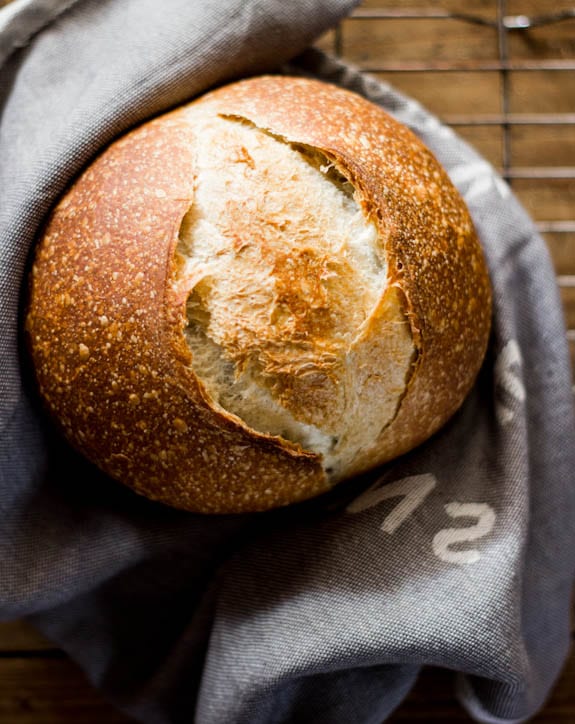
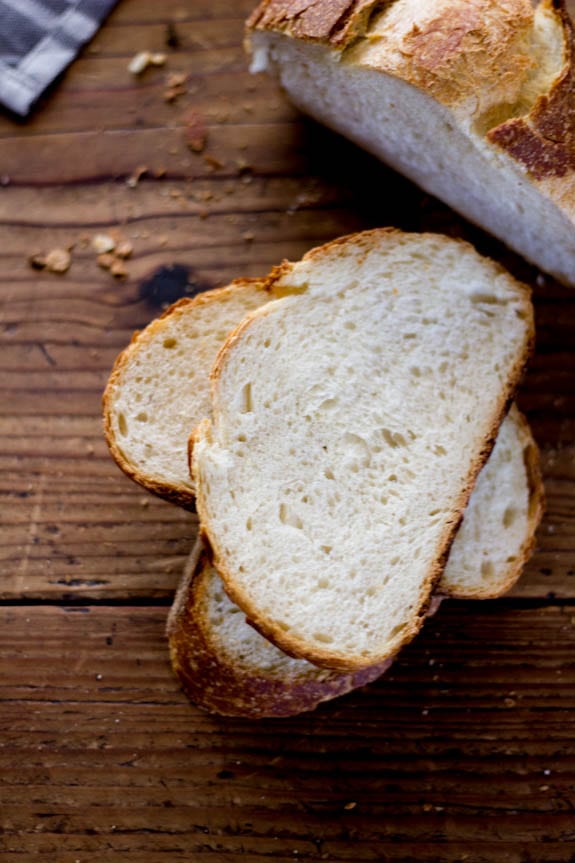
Final Thoughts
There are a gazillion sourdough bread recipes out there. No two loaves look alike. The process is personal. Use this tutorial as a guide and make adjustments as you go. Ask questions. Follow your gut. Once you have a few loaves under your belt, the process will become an imminent rhythm and you’ll become a sourdough pro in no time.
Sourdough Baking Schedule
- Friday Evening: Feed your starter, cover the jar, and leave it on the counter overnight. If you keep your starter in the fridge, it might need two feedings to perk back up (feed it in the morning & in the evening).
- Saturday Morning: Check your starter: if it’s alive and bubbling, you can make the dough to rise during the day. Or, feed it again in the afternoon to make the dough in the evening for an overnight rise. Remember to use the float test mentioned above to make sure your starter is ready to use.
- Saturday Morning/Evening (or whenever your starter is ready): Make the dough. Leave on the counter to bulk rise at room temperature. In the summer, if your dough rises quickly and you’re not ready to bake, cover the whole bowl with lightly oiled wrap and chill until ready to use.
- Sunday Morning: cut and shape the dough. Place in Dutch oven for second rise. Slash. Bake. Cool. Eat.
What’s Next?
- Easy Sourdough Sandwich Bread
- Beginner’s Guide to Sourdough Focaccia Bread
- Light Whole Wheat Sourdough
- Soft Sourdough Cinnamon Rolls
By signing up, you agree to receive emails from The Clever Carrot. Unsubscribe at any time.

Sourdough Bread: A Beginner’s Guide
- Prep Time: 13 hours
- Cook Time: 1 hour
- Total Time: 14 hours
- Yield: 1 loaf 1x
- Category: Sourdough Bread Recipes
- Method: Oven-Baked
- Cuisine: American
- Diet: Vegan
Description
New to sourdough? This easy sourdough bread recipe makes the best artisan-style loaf at home with just 5 simple ingredients: bread flour, active sourdough starter, water, salt and olive oil—my signature addition—known for creating a light, plush crumb and a crisp golden crust. Follow my clear, step-by-step instructions and video guidance to bake fresh sourdough bread with confidence (even on your first try!).
Ingredients
- 150g/ 5.35 oz bubbly, active sourdough starter
- 250g/ 8.80 oz warm water, preferably filtered (see notes below)
- 25g/ .90 oz olive oil
- 500g/ 17.65 oz bread flour (not all purpose flour)
- 10g/ .4 oz fine sea salt
- fine ground cornmeal or parchment paper
Notes & Tips
- For best results, please weigh your ingredients using a digital scale. Because measuring cups vary in size and shape, they are not accurate for bread baking. You want the flour to water ratio to be correct!
- For a more soft and pliable dough, you can increase the water up to 300 g- 325 g total. Please use a cloth lined bowl (instead of the Dutch oven) for the second rise.
- You will need a 5 1/2 or 6 quart Dutch oven for baking
- This recipe was tested with King Arthur Bread Flour, Gold Medal Bread Flour, Pillsbury Bread Flour
Instructions
Make The Dough
- In a large bowl, add the sourdough starter, water and olive oil. Mix with a fork to combine. Add the flour and salt. Continue mixing with your fork until the dough becomes stiff. Then squish everything together with your hands to incorporate all of the four. The dough will be dry and shaggy. Cover the bowl with plastic wrap, reusable wrap or a clean, very damp kitchen towel. Let rest (autolyse) for 30 minutes or up to 1 hour, if preferred.
- After the dough has rested: return to the bowl and work the dough into a rough ball, about 15 seconds.
Note: I’ve given a range in water quantity for the dough (see ingredient list above). If using 250 g of water, the texture at this stage will be quite dry and stiff. If using an increased amount of water, approximately 300-325 g, the dough will be more wet. Both textures are normal, depending on which route you take.
Bulk Rise
- Now the dough needs to rise. Cover the bowl with lightly oiled plastic wrap (alternatively, transfer the dough to a high-sided dough tub with lid and measuring marks). Let rest in a warm spot to rise, ideally 70-75 F. The dough is ready when it no longer looks dense and has almost doubled in size.
Note: The bulk rise time can take anywhere from 3-12 hours depending on the temperature of your ingredients, the potency of your sourdough starter, and your current room temperature. This will be different for everyone. For example, in the summer rise times can take anywhere between 2-4 hours @ 80º F/ 26º C whereas in the winter, the dough will take about 10-12 hours @ 68º F/ 20º C. Watch the dough and not the clock.
Optional Step: Stretch & Fold The Dough
During bulk rise, you have the option to perform a series of ‘stretch & folds’ to strengthen the dough. Start 30-45 minutes into the bulk rise. Gather a portion of the dough, stretch it upwards and then fold it over itself. Rotate the bowl ¼ turn and repeat this process until you have come full circle to complete 1 set. Do this once or twice spaced about 1 hour apart. Although this step is not mandatory, it will increase the total volume and height of your bread. Click here for a step-by-step video tutorial.
Note: Doughs made with 250 g of water vs. 300-325 g of water will feel completely different. The former will be more stiff; the latter will have more elasticity. One texture is neither right or wrong; just different and worth noting for comparison. When in doubt, always give the dough extra rest time in between sets if it won’t stretch with ease.
Cut & Shape The Dough
- Divide your work surface in half; lightly flour one side (for cutting) and leave the other half clean (for shaping).
- Remove the dough from the bowl, and place onto the floured section so that it does not stick. You do not need to ‘punch down’ the dough; it will gently deflate as you fold and shape it.
- Cut the dough in half to make 2 loaves, or leave it whole for a single loaf.
- To shape: use a bench knife to move your dough to the non-floured section (if there is any flour present, it will be difficult to shape- brush away any excess). Starting at the top, fold the dough over toward the center. Give it a slight turn, and then fold over the next section of dough. Repeat until you have come full circle.
- Then flip the dough over and place it seam side down. Using your hands, gently cup the sides of the dough and rotate it, using quarter turns in a circular motion. You can also pull it towards you to even out the shape. Repeat this process until you are happy with its appearance.
Note: When shaping, the idea is for the dough to catch enough surface tension on a non-floured area in order to create a tight ball. If there is flour present, it will slide around… and drive you nuts.
Second Rise
- Now the dough needs to rise again, but for a shorter period of time.
- Coat the bottom of your Dutch oven with cornmeal. Alternatively, use parchment paper to prevent sticking (this is what I do, now). Place the dough inside of the pot for a “free form” second rise, about 30 minutes to 1 hour. Cover with the lid of the pot. The dough ready when it is slightly puffy but not double in size.
- Preheat your oven to 450º F/ 232º C towards the tail end of the second rise.
Note: The “free form” second rise in the pot works best with a dough made with 250 g of water. It won’t spread. If your dough contains more water, skip the free from rise. You’ll need to do the second rise in a cloth-lined, floured proofing basket instead. The basket will hold its shape to prevent spreading.
Score The Dough
- Right before your bread goes into the oven, make a shallow slash about 2-3 inches long (or more) in the center of the dough. Use a bread lame, razor blade, sharp pairing or a small serrated steak knife. The cut should be about 1/4-inch deep.
Bake The Dough
- Place the bread into the oven on the center rack (lid on) and reduce the temperature to 400° F/ 204° C. Bake for 20 minutes. Remove the lid, and continue to bake (uncovered) for an additional 40 minutes or until deep, golden brown. Keep in mind that all ovens are different; you might have to make minimal adjustments to these temperatures.
- You can also take the internal temperature of your bread to double check that it is done. For sourdough, it should read about 205-210º F/ 96-98º C.
- Remove the bread from the oven, and cool on a wire rack for at least an hour before slicing. Don’t cut too soon or else the inside will have a gummy texture!
Sourdough FAQ
1.) I only have all purpose flour. Can I still make this recipe?
For best results, use bread flour for this dough. If you only have all purpose try my Artisan Sourdough with All Purpose Flour instead.
2.) Can I add whole wheat flour to this recipe?
You can, but I wouldn’t. The dough will be too dry and dense without adjusting the water quantity. Try my Light Whole Wheat Sourdough for more whole grain goodness.
3.) Your beginner recipe here uses 150g of sourdough starter. The Everyday Sourdough in your book uses only 50g. What’s the difference? And why?
- When I first learned how to bake sourdough bread, I used 150g of starter. Overtime, it was too much to maintain (especially when doubling and tripling recipes). So, I scaled down. That’s why most recipes in my book Artisan Sourdough Made Simple include 50 g of starter instead. One amount is neither right or wrong; it’s just a matter of preference.
4.) What’s the purpose of olive oil in this recipe?
Adding olive oil to sourdough was the method I followed when I first learned how to bake. The natural fat emulsifies the dough and makes a plush crumb.
5.) Why do some of your recipes call for the second rise in a Dutch Oven? And others in a cloth- lined bowl?
The freeform Dutch oven second rise will only work with dry, low hydration doughs (like this one) because it will not spread out too much. On the flip side, when working with wet, high hydration doughs you’ll need to use a cloth-lined bowl sprinkled with flour to holds it shape. Otherwise, it will spread.
6.) Why don’t you preheat your Dutch oven before baking?
Because this recipe follows a freeform second rise directly in the baking pot, it cannot be preheated beforehand. The dough will begin to cook before going into the oven!
However, if you are doing the second rise in a cloth-lined bowl as mentioned in question #5 above, you can preheat the pot if you’d like. When bread dough is placed into a hot pot it begins to expand instantly which is great for the overall shape and structure of the bread. And in fact, I use to follow this technique when I first started baking. But overtime, I found the preheat to be too cumbersome for small kitchens with little kids running around. Plus, I kept burning my wrists. Long story short: you can achieve comparable results without the preheat. The choice is up to you.
7.) Can I halve the dough to bake 2 loaves? If so, what will that do to the baking time?
Yes, you can definitely halve this recipe. Bake for 20 minutes (lid on) and 30 minutes (lid off). Check at the 45 minute mark.
8.) If I halve the recipe, where should I store the second dough if I’m not baking at the same time?
Store the second dough in the fridge until ready to bake. Place the dough in a cloth-lined floured bowl (seam side down) and use the cloth overhang to cover it. If the dough is in the fridge for longer than 1 hour, rest at room temperature while the oven heats up.
9.) How do I get the dough out of the cloth-lined floured bowl?
Open up the cloth overhang to reveal the dough in the bowl. Place a piece of parchment paper on top of the dough. Flip the bowl over. Remove the bowl and cloth. The dough is now smooth side up and ready to be scored.
10.) Can I have the measurements for this recipe in cups, please?
- 3/4 cup bubbly, active starter
- 1 cup + 1 tbsp warm water
- 2 tbsp olive oil
- 4 cups bread flour
- 1 1/2 tsp fine sea salt
NOTE: Weight and volume measurements are not equivalent, only approximate. I strongly recommend weighing your ingredients instead. With that said however, I understand the convenience of measuring cups. For best results, please aerate the flour first (I fluff it with a fork directly in the bag), then lightly spoon and level it into the cup. Too much flour will make the bread dense. If your sourdough starter is very bubbly, the volume amount might be off. If necessary, add up to 1 cup as needed. Finally: the water can be increased up to approximately 1 1/3 cups, for a more soft and pliable dough.
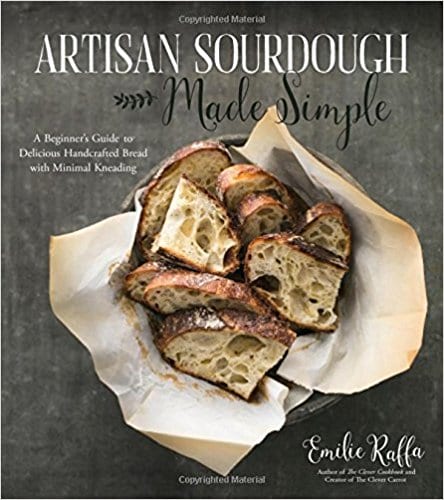


Comments
Eli says
Can I use a loaf pan instead of a Dutch oven? What about an aluminum pot? I’m making the starter as I’m writing the comment, so I’d like to know so I don’t end up with an alien creature from the deepest depths of 2021.
Emilie Raffa says
Any pot with lid is fine! Just make sure the entire thing (handles, lid, etc.) can heat up to 450 F.
Alternatively, you can bake this in a loaf pan but it will be sandwich bread instead. Sandwich bread requires a different shaping method, rest time and baking time. Follow my instructions here. Good luck!
Jim Basinger says
Emilie,
A problem with sourdough that I encountered, but I have not seen mentioned anywhere, concerns pH of the water supply. Tap water that is 8+ (alkaline) inhibits microbial growth, and can prevent starter from, well, starting. Tap water in my city is as high as 8.5, which is deliberate, as more acidic water leaches lead from old pipes and joints. Most municipalities post chemistry of their water supply on their civic web site, and I know from my own research that many cities have similarly high Ph. A pinch of citric acid to my starter completely resolved this issue. An appropriately greater amount (may 1/8 tsp) to a batch of bread is advisable. Just wanted to pass along this tip. Your web page is well presented.
Emilie Raffa says
Jim, this is a very good point. Water quality can definitely effect the strength of your starter and overall baking. Thank you for taking the time to share your experience with us. I know it will be very valuable for bakers having the exact same issue.
Rita says
I tried this recipe last night using my neighbours starter. So easy, so delicious! I don’t have a Dutch oven but baked it in my turkey roaster that was placed on a pizza stone. The crust was amazing! I started last night did the stretch and fold 1 and 2 hours respectively into the process and left it to bulk rise overnight (12 hours in total). Did the final cut and shape this morning. The only thing was that I did add a bit too much salt as I think my scale wasn’t very precise (I’ll measure it out next time) but I’m hooked and will bake another loaf tonight. Thanks for a great recipe!
Emilie Raffa says
Rita, thanks so much for the tips (especially the Dutch oven baking pot alternative). So glad it all worked out! Regarding the salt: did you use fine sea salt? Some brands/types are saltier than others… just something to keep in mind even if measured correctly :)
Luis says
Im trying this technique out, my bread is in the middle of the bulk rise as I type this! I m hoping to get some clarity as to how to go about doing the second rise in a bowl, as I want to try having the Dutch oven preheated for the bake. In the comments it says to flip the dough onto parchment and remove the clothe and bowl. This means that the second rise happens with the dough upside down? Meaning, when putting it into the Dutch oven, the part that touches the bottom will be the pet that is not touching the bowl during the rise? This makes sense but I might be fussy because I’m excited to bake this in the morning!
Emilie Raffa says
Yes: the second rise happens with the dough seam side up. Then, you’ll place the parchment over the bowl, and flip it over. After you remove the bowl and cloth, the dough will be smooth side up. Hope this helps!
Sandra says
After two different recipes and 3 failed attempts at sourdough, this one finally came out decent. Next time, I will try with more water for a lighter crumb. Thank you!
Emilie Raffa says
You are very welcome, enjoy!!
Sara Srygley says
Made this as my first loaf yesterday and cut this morning- the crumb was lovely and the flavor is great. However, I failed to achieve the split open crackly crust pictured with the recipe and so longed for! I had more of a soft crust result and the splace where I slit the dough baked to the same color as the rest of the loaf.
Any ideas on what might have gone wrong? I let rise in a warm room for 9 hours and baked in a cast iron dutch oven.
Gina says
Thanks I’m going to have a go…
kim says
thanks so much Emilie!!!!
thanks to you and being so available to answer my questions, i think i finally understand the science!!! the loaf i made w. the reg KAF turned out ok. but i fed Denny and he was very happy again tonight so got more dough made w. KA bread flower!!! So excited as I finally get it….after this loaf (that i promised to my daughters boyfriend) I will move on to some of your other recipes in your book. Again thank you for walking along side me…
May you have a blessed 2021!!
-kim from SC
Emilie Raffa says
Kim, I’m thrilled you stuck with it. Makes me so happy! Sourdough is a lot of trial and error, but once you get the hang of it, it’s like second nature. :)
kim says
so made the basic sourdough in your book the other day….my family loved it! question….at what point would i add say rosemary or other herbs to the dough? and….how may sets of stretch and fold should be done?
-k
Emilie Raffa says
After autolyse (first rest) would be best! For this particular dough, because it’s low hydration, extend the first rest up to 1 hr; the texture will be softer and easier to incorporate the herbs. For the folds, you can do as many as you want- it’s up to you!
kim says
thanks! :). I have been letting them sit for an hour during the autolyse. I live in an older home and i dont keep it super warm in here so figured any extra time will help. No hurry….fed Denny last night after I mixed up some bread dough…will bake this morning and he is happy again this morning….so will mix up another later…maybe bake tomorrow. Still learning but having fun!
-k
Sarina Grady says
Hi! Beautiful step by step recipe! So I have my bread in a bulk rise right now- and I just realized I was supposed to use bread flour instead of all purpose- oops! Should I still follow the recipe and just expect it to not taste as it should? Do you always use bread flour for sourdough? Other recipes I have made use all purpose and I understand the protein content is different but why is one better for sourdough? Thank you!!
Laura R says
My first time baking sourdough and it turned out nearly perfect. The loaf was beautiful and the crumb was perfect, moist and airy. I thought it was pretty easy. I had two issues that were my fault and would correct next time. One is my bread wasn’t tangy enough for me and the second is the bottom browned too much. Those should be easy to fix. Thanks for the recipe and great instructions.
CelticDragonfly says
This was an easy to follow recipe – each time I complete the process the bread turns out better and better. Thank you!
Swami says
First time baker here. This recipe was spot on! Best sourdough ever! The instructions were perfect. Thank you!
Kathleen Kono says
First time Sourdough Bread Maker and this recipe was spot on awesome! I love the step by step process. I received my starter from a friend and just kept feeding it for a month before I worked up the nerve (and had the time) to use it. The bread turned out amazing and the process was not as intimidating as I had thought. Thank you!!
Emilie Raffa says
Thank you Kathleen! Thrilled to hear this :)
Caroline Overman says
If I need to put the dough in the refrigerator because I’m not ready to bake it when it’s done rising, how long can it be refrigerated for and do I need to let it come to room temp before shaping it and putting it in the Dutch oven?
Emilie Raffa says
Hi there! To clarify, at what point are you putting the dough in the fridge- bulk rise? Or second rise? Thanks!
Caroline Overman says
After the bulk rise! What do you suggest?
Heather says
Thank you so much, this makes baking sourdough bread seem much less daunting!
Susan says
I learned how to make sourdough with your book. Love it. Jalapeño cheese is my favorite. After reading one of your recipes above and noticed you used way more than the fifty gm in your book. Does that mean I could use 65 or 70 gm of starter and keep the flour measurements the same as your book. Just wondering. What does more starter add to bread
Emilie Raffa says
Hi Susan! Yes, the recipe here uses more sourdough starter. In the book I use less (as time progressed, I preferred a smaller amount because it was easier for me to maintain). To answer your question: sourdough recipes are formulated to work with a specific ratio of starter, flour and water. This means you would most likely have to make additional adjustments to the recipe, rather than just adding more starter.
Richard says
Hi again @Kim,
Sorry, my bad… Emilie uses feed weight = 2x starter weight (so you were correct)
I feed my own starter half its weight in flour and half its weight in water as I described… I still works fine for me and reduces the food bill ;-)
My apologies for the confusion.
Arlene says
I am following your recipe but my bread is still a little gummy in the middle. I can’t figure out what I’m doing wrong
Emilie Raffa says
Gummy bread usually means that it’s undercooked or the loaf was cut too soon after baking. I’d recommend using an oven thermometer to check your oven temperature for accuracy, and to wait the full after baking before cutting.
April says
I made this recipe last weekend and it was amazing! I’ve tried several different recipes and techniques and this will be the one I stick with, thank you! I am wondering if you can use this recipe and shape the dough into baguettes? If so, would you recommend cutting into two loaves or modifying the cooking time or anything else?
Katina says
What size Dutch oven would you recommend? I was considering at 3 qt to keep the bulk of another pan down. Will it be big enough?
Emilie Raffa says
Katina, I think a 3 qt might be too small (I usually recommend a 5 qt). But if that’s all you have, you can divide the dough in half and bake two loaves, if you’d like.
Tara says
Hi! I’m loving this site and the sourdough I’ve been making. I have a question regarding bulk rise, is it okay to let it rise for more than 12 hours? For instance, making it in the evening with enough time to get a couple of stretch and folds before going to bed?
Thank you again!
Tara
Emilie Raffa says
Tara, it depends on the temperature! For this recipe, when the weather is cold, I’d suggest making the dough in the evening (with a few folds) to let rise overnight. It should be ready in 12 hrs. You don’t want it to go too much past 12 hrs, otherwise the dough will overproof.
Regina says
im a newbie to sourdough bread but i baked twice using your recipes and they turned out really well 😊 if i wanted to add garlic or onion powder when will be the best time to put them in?
Emilie Raffa says
Hi there! For onion or garlic powder, you can add them at the beginning (when you mix the dough). Yum!
Kim says
I originally posted on the starter but felt i needed to clarify so reposing here. I have starter but am wanting to make this bread…. I am so sorry to be so high maintenance….i just really want to do this! I love learning new things and this has definitely been a challenge…I cook and bake all the time but this….has me stumped!
I fed last sunday w/ KA APF…put in refrigerator and took out last night…disgarded 1/2 and fed w/ 60=60 and have left if covered on the counter since last night. I actually did put it in the oven overnight w. light on….but it has not doubled. It is bubbly, smells good and not as thick as it has been but has only risen just a small amount. IDK? I live in an old home and keep it 68-70. Do you think it just needs more time or should i feed again? and if i feed again to clarify…..discard ~60g and add 60+60+ or all equal parts?
Emilie Raffa says
Kim, sometimes your starter just needs more time to activate especially when it’s cold! Next time, I’d feed it for a few days (stored at room temperature) before using. Skip the fridge. This way, you’re giving it enough time to build up strength. The more you feed it, the stronger it will be.
Regarding the feeding quantities, when you discard half, you feed the remaining amount in the jar with equal parts by weight. So for example, if you have 120 g starter, after discarding half, you’d feed the remaining 60 g of starter with 60 g flour + 60 g water.
Kim says
Yes Emilie!
I thank that was the issue…a bit colder in my home! So in preparation for this weekend , I discarded and fed on Thursday and left him (Denny after my Daddy because he got hold of some starter as a kid and always made pancakes) …and left him on the counter….i fed again last night and put him in the oven after it was still slightly warm after i had baked a pizza and this morning he was very happy (bubbly) doubled and floated! I have all my ingredients mixed and letting it sit for the 30-1h. I live in an old house so not always the warmest. I did turn up the heat so hopefully that will help w. success.
As far as feeding….i think i am getting the concept….I had 180g in my jar last night so after pulling off 150g for your recipe, left w. 30g so fed w. 30 + 30g. .i put him back in the frig. and when i feed again pull off 45g and feed w. 45 + 45g? or can i pull off 30g leaving 60g. and feed 60 + 60g (because that is about the 1/2c and 1/4c)
and to clarify….when i feed, i always have to pull of something right?
I do have your book and am looking forward to tackling more of your recipes….but really want to get the basic understand down first. I really appreciate you taking the time to walk me through this…. Will keep you posted :)
-k
Emilie Raffa says
Hi Kim! EXCELLENT!
Yes: you can absolutely pull off 30 g (instead og 45 g) leaving a 60 g balance to feed. The discard amount doesn’t have to be exact- going by half is a general guideline. And also, it’s best to discard before feeding every time. The exception is when you want to build up the quantity of starter.
Kim says
yay!!!! I made it last week for Christmas Even and IMO….it was perfect!!! Was going to make another loaf yesterday but my sourdough was not ‘happy’ enough so i fed him and today he was super happy so….Ive combined BUT….dummy me used reg. KAF instead of the bread flour!!!! So now curious…..whats the difference between the two and why do you recommend the one over the other for this recipe?
-k
Emilie Raffa says
Hi Kim! Bread flour has a higher protein content than regular ap flour. High protein = strong gluten development which creates a lofty-high rise. It also absorbs more water than ap flour so the mixed dough will feel totally different. You can still bake bread with ap flour, but texture, taste and shape will differ than loaves made with bread flour.
Kat says
This is the first and only sourdough recipe I have ever been able to make successfully. Everything else turns to a flat dense weird mess? I swear I’m doing everything right. This one always works though. It’s magical.
Emilie Raffa says
Yay! So glad! Thanks for the feedback, Kat ;)
Ola says
Very good recipe, bread turned out perfect! I really like the olive oil addition. It creates fantastic flavor and moist bread.
Emilie Raffa says
So glad you liked it! Isn’t the oil a nice touch? Creates such a plush crumb :)
Natalie says
This worked great!! I’ve been experimenting with different sourdough recipes, and this is the only one where I could actually score the dough. Every other time it’s been too soft to even hold a shape without the dutch oven. I’ll definitely make again!!
Emilie Raffa says
Thanks so much for your feedback, Natalie! So excited for you!
Kayla says
I found your blog 4 years ago and have been enjoying homemade sourdough bread ever since, thank you! I recently bought your book and am making the cinnamon swirl bread. If I use 150g starter what would the conversion of water needed be? Also, I only have a round Dutch oven, would that be a problem for recipes using an oval pot? Thank you so much for making sourdough baking easy and delicious!
Emilie Raffa says
Hello Kayla! Thank you SO much :) To clarify: are you referring to the swirl bread in the book? Or the one on the blog? Thanks! xx
Hayley says
Hi thanks for sharing this recipe. I am just starting out making sourdough bread but wanting to make rye sourdough. Can this recipe be used with rye flour. Because of health issues I am looking to buy a mixer to make the sourdough bread in , is there any that you have tried and can recommend. I would like to have one that last some time
Emilie Raffa says
Hi Hayley! Unfortunately, it won’t work with rye flour. Sourdough recipes are specifically formulated to work with certain types of flour (and water ratios). Even swaps don’t usually work. I’d suggest searching for a specific rye sourdough recipe (I have 2 in my book). For stand mixers, I use a KitchenAid and love it!
Ruben Hinojosa says
From the starter to the sourdough bread, I used your recipe as a guide not point by point, and I have sourdough!!! Thank you 🤓
Emilie Raffa says
Fantastic, thank you!
Sandy C says
I cannot thank you enough for sharing this recipe on your blog. I also purchased your cookbook not only to enjoy the recipes, but as a thank you for sharing this recipe. I make this bread once or twice a week and it is simply amazing. I love my weekly chemistry project. I used to bake all of the bread for my family and it was quite good, but not this old European method of making bread, which I enjoy so much more. I kept my sourdough starter alive for around 6 years and then became distracted with my children. My new sourdough starter is my new baby and is getting a lot of attention. Thank you, thank you, thank you! Your technique is perfect for this loaf of bread and the mini course in master baking is so helpful.
Emilie Raffa says
Sandy, you are so incredibly kind. Thank you for taking the time to leave such a thoughtful note. Happy baking! xx
Elena says
I have tried (and failed) at many sourdough recipes and was starting to accept it as a personal problem, until I found this beginner-friendly recipe. And finally, success! Not perfect, but definitely a loaf worth eating (it was half gone by the 1.5hr mark out of the oven). This recipe was a great balance of hand-holding without being overwhelming. I’m excited to try it again now that I know it better. Thank you!
Diana G says
Great recipes, tips and instructions. Great results!
Johanna Summers says
This is the best recipe I’ve ever used. The bread turns out so well. Thank you! I had almost given up!!
Charlie says
This is a great recipe! I have been using it for many months now and enjoy it just the way it is presented. Thanks so much!
Nick says
Thank you for this great guide. When I first tried this, I couldn’t get bread flour anywhere….it was all sold out. So I went ahead and used regular organic all purpose flour (I know, organic is somehow not the best for this but it’s what we had) It turned out great every time!!! Then bread flour started appearing back on the shelves and I thought, if my all purpose flour loaves are turning out so well, then the bread flour will make it even better! But it’s been the opposite….starter looks great, it actuary overflowed on my today and made a happy mess. But my loaf is small….the long rise goes great, then the short rise before baking just doesn’t…well “rise”. What am I doing wrong?
Abigail Lane says
I am making this for a second time and my first loaf burst, could it be a scoring issue? I did the 4 scores at 12, 3, 6, 9 and it doubled in size in about 5 hours for the bulk rise. I got a starter earlier this fall and am looking forward to more bread making!
Karens says
I made this recipe for the first time the other day and my first attempt was pretty good! I’ve got a ways to go to perfecting things, but I had a question. When taking the dough out of the fridge after proofing, should I throw it directly into the preheated dutch oven (after scoring), or should I wait for the dough to warm up a bit before scoring and putting in the oven? I ask because I was having a bit of trouble scoring the fresh out of the fridge dough.
Emilie Raffa says
Hi there! It all depends. Would you mind describing the particular issue with the scoring? It will help me troubleshoot. Thanks!
Rachel says
Your Beginner’s Sourdough is fantastic – my family says it tastes just like the famous Acme Levain bread from Berkeley, only better! I love baking in my Dutch Oven. I’d like to make this recipe into smaller rolls. Do you have any suggestions on how to do them in the Dutch oven?
Emilie Raffa says
Oh wow, that’s AMAZING!!!! Fantastic, Rachel. Thanks so much for sharing :)
For smaller rolls, although I haven’t tested it myself, you could probably do it in a Dutch oven lined with parchment paper. To achieve the same style crust, I’d cover the pot for the first part of baking and then remove it later on to crisp the outside. Bake time will be less than the standard-sized loaf. Enjoy!
Demi says
Hi Emilie,
I’ve followed this recipe a few times now without realizing it said to use bread flour and I’ve only used white all-purpose flour. I haven’t had an issue with the dough being too sticky but I don’t quite have the hard crust that you expect with sourdough; is this because of the flour I’m using? I’ll have to try your recipe with all-purpose flour now that I know I’m making a mistake!
Emilie Raffa says
Hi there! It all depends. While flour type does have some effect, a softer crust usually indicates how the loaf was cooled. Next time, try baking the loaf directly on the rack (no pot) for the last 10 minutes. When finished, allow the loaf to cool down in the oven with the door open for a little bit. Then remove to a wire rack. This entire process will help crisp the crust and cool it down gradually.
Judy says
Hello and thank you for your informative video! It’s the best of ALL the instructional videos I’ve watched.
I did make the recipe and got a beautifully shaped crispy loaf, but the flavor is lacking something I can’t put my finger on. Perhaps I need a more sour starter. How do I achieve that?
Emilie Raffa says
Hi Judy! If you’re looking for a more “sour flavor” try a combination of the following:
1.) Keep your starter more acidic (don’t feed it that often; it will smell more vinegary than fruity)
2.) Bulk the dough at a warm room temperature (80 F) followed by an overnight second rise in the fridge
3.) Add 25g of whole wheat flour for an enzyme boos (add more water to the dough to compensate)
In my experience, achieving a stronger sour flavor has to do with adjusting your method and variables. It’s not just one thing!
Liesl Coates says
Wahooo! I just finished the Rosemary Garlic Bread from your book (everyone: do yourself a favor and buy the book!) and it’s the best piece of bread I’ve EVER put in my mouth! It’s a higher hydration dough, and somehow I managed it, and the only complaint I have is that I cooked it a tiny bit too long on the rack in the oven for the final minutes. It got a bit too dark. I should have followed my gut and not the black and white directions- still working on this development! I must say that I loved your new post about “when you do everything right and your dough doesn’t rise overnight. Been there, done that, and I absolutely agree, for me it was about temperature. I began putting it in my oven with the light on- with an additional light inserted on the rack. The temperature would say at least 70 degrees, but it would still take a long time. The key to your post to me was: watch the dough not the time! I still wonder, though, if “older” starters are going to be stronger and cause things to bulk faster.
Emilie Raffa says
Hello my friend! Ahh, thank you SO MUCH! How yummy does that rosemary garlic bread smell? I haven’t made it in a while and now I’m in the mood ;)
Yes: always follow your gut. Recipes, quantities, timeframes… all of these things are guidelines that absolutely can be (and should be) adjusted to suit your situation. Even the most experienced bakers still make changes as they go. That’s how you learn, get better and eventually excel.
Liesl, have you considered purchasing a proofing box? It’s basically a temperature controlled “greenhouse” for your dough. You set it to your desired temperature, pop the dough inside, and then leave it be. No babysitting. No worries about temperature. Plus, you’ll have a better idea of how long the dough will take to rise because the temperature will always be consistent. I don’t always use mine, but I highly recommend it for those who want more control over their dough.
Regarding starters: older starters are usually stronger because the bacteria is well established. However, a starter’s strength is nothing without temperature. You need both for a successful, predictable rise.
x E
Lori Ann Mancini says
Hello! I’m really enjoying this site. I’ve made my starter and am making my first loaf now. I started the bulk rise and did the stretch and fold twice, now letting it rise overnight. I did forget to add salt though! Should I just let it go at this point? Or add it in after this rise? Thank you for sharing your recipes!
Emilie Raffa says
Oh no! I’m probably getting to you too late now… But in the future, should this happen again, you could most likely add the salt about 2 hrs into the bulk rise without any issues. I’d consider dissolving it in a bit of warm water first as it will be easier to incorporate into the dough :)
Raul says
Hello,
Sorry for the silly question, but this is my first time trying to make sourdough… I’m making the starter from scratch, but have a question (might be related to the fact that English is not my first language :)).
So, recipe says: “ Here’s my method: I pour off some of the culture (about half) and then feed what’s left in the jar with equal weights of flour and water.” What do you mean by pouring off Half of it? Like throw away half of it and work with the other half? Or take half of the starter, feed it to make the levain and then keep the other half in the fridge for the future? Also, do I need to feed the second half? If I keep it in the fridge and it b Here’s my method: I pour off some of the culture (about half) and then feed what’s left in the jar with equal weights of flour an pd it becomes dormant… next time I’ll only have half of the starter, right?
Sorry if it’s a really silly question!
Thank you!
Emilie Raffa says
Hi Raul! Not a illy question! Yes: it means to pour off half of your starter (discard what you pour off), and then work with the other half.
However, the second part you mentioned can be done to create a levain. Some bakers do this to keep their “mother starter” untouched. The half you keep in the fridge should be fed once a week to keep it alive.
Hope this answers your question!
Tgg says
This is the first time I made sourdough, and it turned out really well, thanks to this recipe. Thank you. I was just wondering, if I halved the quantities, could I just make one, smaller loaf?
Emilie Raffa says
Hi there! You can absolutely do this. Just watch your rise times and reduce the total bake time to about 50 minutes total :)
Holly says
Hi there so I’m making your starter and bread recipe and I’m just wondering, what is the use of the oil in this recipe because I’m most of the other recipes I’ve seen doesnt call for that and if I don’t want use it what would I have to change?
Emilie Raffa says
Hi Holly! Great question. I’ve included the answer in the FAQ section at the bottom of this post (below the actual recipe). Hope this helps!
Holly says
Hi, I’ve just read it but I’m curious if you left it out, would it affect the taste. Would you or would you not recommend skipping on the oil?
Emilie Raffa says
Hi there! Depending on the brand and type you’re using, it will only add depth of flavor (not something that’s overly pronounced and noticeable). The oil really just effects the texture and crust. I’d recommend doing it both ways to see which you prefer! Just a heads up- if you do choose to omit the oil in this recipe, replace the full amount with water. Enjoy!
Meehir Patel says
Hi Emelie,
I really appreciate this guide, very simple and inviting when it comes to baking with sourdough, thank you.
I am based in the UK so I used strong white bread flour for this recipe with a little bit of plain flour as I was just short of the 500g of bread flour just to be transparent and I let it rise for 12 hours as instructed, however upon removing the dough from my bowl, I found the dough to be quite sticky and I noticed that my bowl did not look as clean as yours when removing the dough from the bowl like it does in your video.
I tipped out the dough on a lightly floured surface but it was super sticky to work with and I was not able to shape it the way it looks in the video…
Can you help me please, what am I doing wrong!?
Thank you,
Meehir
Emilie Raffa says
You’re very welcome, Meehir :)
The sticky dough could be a few things: it’s possible your dough was over proofed, meaning it rose for too long (rise times will vary based on temperature; it doesn’t always have to be 12 hrs.). Next time, allow the dough to only double in size.
Additionally, add a few stretch and folds during the bulk rise. After the third set, you’ll notice the dough won’t stick to the bowl as much and it will look more like the video.
Then, the dough won’t be so sticky during the final shaping process.
Hope this helps!
Amy M says
Thanks for all of the resources! I’ve been making this all summer and it always turns out great. When I make two full sized loaves I usually make them separately but I’m wondering if I can double the recipe and then split them at some point. Thank you!
Emilie Raffa says
Hi Amy! Absolutely. To double the recipe in one bowl, you’ll have to find a something large enough for the dough to rise like one of those plastic tubs or a very large mixing bowl, if you have one. Then, after the bulk rise, you’d split the dough in half before proceeding with the rest of the instructions.
Amy m says
Thank you so much! I tried doubling it today and it worked perfectly.
Emilie Raffa says
FANTASTIC! Glad it worked out :) x E
Mary says
At the beginning of bulk rise, should bowl be covered with damp towel again ?
Emilie Raffa says
Hi there! Yes, cover with a damp towel or lightly oiled wrap.
Claire says
Hi! I’d like to split the dough in two as you suggest. Does this change the temperature or baking time? Also, if I have (2) dutch ovens – can I bake both halves in the same oven at the same time?
Emilie Raffa says
Hi Claire! You can find the answer to this in the FAQ section above! Additionally, if your oven can fit two pots side by side, then you can definitely bake the two smaller loaves at the same time.
Martha says
I have searched for a really good sourdough recipe not only because they taste great, but also because my daughter is gluten intolerant and sourdough never upsets her stomach as the other breads do. We all LOVE this recipe! It is my go to for an easy loaf to make and tastes fantastic! Thank you for sharing it! I would like to use my sourdough starter to make pizza dough. We like crispy crust but I don’t have a recipe that I am in love with, any recommendations? Thank you!
Emilie Raffa says
Yay! So happy to hear this Martha! For the pizza, are you looking for thin & crispy? Or just regular pizza with crispy crust? Thank you!
Preety Aggarwal says
Thin & crispy here!